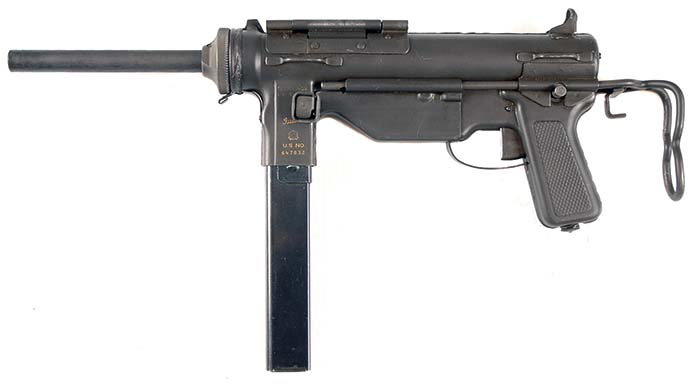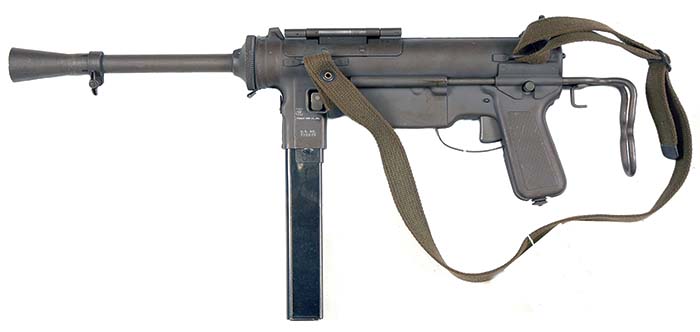Circa 1950, a U.S. soldier strikes a threatening pose with an M3A1 “grease gun.”
By Frank Iannamico
Brief History of the M3/M3A1 Grease Gun
Even before U.S. troops encountered the German’s revolutionary stamped sheet-metal MP40 maschinenpistole during World War II, the Army was searching for a new cheap, easy to manufacture submachine guns. On February 6, 1941, a requirement was set by the Small Arms Development Branch, Technical Division of the Ordnance Corps for the replacement of the Thompson submachine gun. The U.S. Army tested over twenty foreign and domestic submachine gun designs in search of a suitable replacement for the Thompson. After an exhaustive evaluation program, the U.S. Army accepted a submachine gun design by Hyde-Inland, briefly adopted as the M2 submachine gun.

While the Hyde-Inland submachine gun was being readied for series production, another George Hyde submachine gun design was under development. The prototype was designated as the select fire T15. The design used no critical metals and required a minimum amount of time consuming machining. Except for a few parts, the weapon was made from simple sheet-metal stampings. The bolt assembly rode on two steel rods that were secured by two holes punched into the rear of the receiver. The front of the rod/bolt assembly was secured in a steel plate, held in place by the barrel, which was simply screwed into the front of the receiver. The bolt would slide on the two steel rods, never touching the inside of the receiver. This kept the moving parts impervious to dirt, making it an extremely reliable design.
As the project progressed, there were a few changes implemented: a low cyclic rate and a full automatic-only operation. An additional requirement was set for an easy conversion to the 9mm cartridge that was common in Europe. The new prototype weapon was designated the T20.

U.S. Army Ordnance R&D officer Réne Studler recruited General Motors to assist with the T20 development. Fredrick Sampson, Chief Engineer of GM’s Inland Division, was assigned to the project. After the successful, thorough testing of the T20 prototypes, the T20 was officially adopted as the U.S. Submachine Gun, Caliber .45, M3. The M3 T20 prototype had an overall score of 95 out of a possible 100 in the Aberdeen submachine gun trial, higher than any previous weapon tested. The new submachine gun was adopted by the U.S. Army on Christmas Eve, 1942.
On January 29, 1943, the Guide Lamp Division was given an order to manufacture 300,000 M3 submachine guns at an initial cost of $17.93 per unit, minus the bolt assembly. This cost would be amended several times during the life of the Guide Lamp contract. The contract for the M3 bolts was awarded to Buffalo Arms at a cost of $2.58 per piece. New M3s were being delivered to the army from Guide Lamp by the summer of 1943. The first M3 submachine guns were issued to Rangers, paratroopers, and armored crews. The U.S. Marine Corps would also issue the M3 by the war’s end.

At the peak of production, Guide was turning out a new M3 submachine gun every 2.4 minutes. A total of 605,694 M3 models would be accepted by the Army from 1943 to the end of 1944. The simplified M3A1 model was only produced in 1945 and 82,281 were built by Guide Lamp before production ceased in August.
The Ithaca Gun Company
The Ithaca Gun Company’s first involvement with the U.S. M3 submachine gun was when they were awarded a contract to manufacture spare bolt assemblies in 1953. The new bolts were needed to replace those that had become worn or otherwise unserviceable. Ithaca produced 90,136 replacement bolt assemblies for the M3 from 1953 to 1954 under Ordnance contract DA 30-115-ORD-355. On February 22, 1945, the Ordnance committee recommended that the M3 and M3A1 submachine guns replace all Thompson model 1928, M1 and M1A1 submachine guns in current service. This request was so the Army would not have four types of weapons for which to provide parts and maintenance. It was suggested that M3A1 submachine gun production be increased to meet the number of weapons that would needed to completely replace the Thompson. It was estimated that 151,311 additional M3A1 submachine guns would be needed by 1946. The war ended before the increased submachine gun production ever materialized. In a post-war memo dated March 27, 1946, it was stated that there would be a deficiency of 50,000 M3 and M3A1 submachine guns, even considering the reduced post-war requirements. As a result, the Thompson submachine guns were not to be taken completely out of the U.S. Army service at that time.

In the early 1950s during the Korean Conflict, the Ithaca Gun Company was contracted through the Rochester, New York Ordnance District to fabricate 70,000 new M3A1 submachine guns. The manufacturing would be authorized under contract number W-19-058-ORD-7894. Preparation for the manufacturing would be assisted by a technical data package documented by Guide Lamp during their manufacturing of the weapon. Delays in getting production started resulted in the Ithaca M3A1s being manufactured in 1955-1956, after the war in Korea had ended. The Ithaca manufactured M3A1s were nearly identical to the earlier Guide Lamp models (M3A1). The receiver markings were different and the parts were all coded ITG for Ithaca manufacture. The diamond-shaped “checkering” pattern impressed on the pistol grip of the Ithaca M3A1 also differs slightly from that of the Guide Lamp guns.
Parts were 100% interchangeable between the Ithaca and the M3A1 Guide Lamp models. During the Korean War, many replacement parts were manufactured by a number of private contractors. Springfield Armory and Rock Island Armory were also producing spare parts for both the M3 and M3A1 submachine guns.

In 1957, a long-awaited new infantry weapon and 7.62×51 caliber round were introduced. They were hailed as being the consummate service rifle and cartridge. The new weapon was the 7.62mm U.S. Rifle, M14. There were several configurations of the M14 planned. They were designed to fill the roles of several other small arms to include the M1 Garand rifle, M2 carbine, Browning Automatic Rifle, and the submachine gun. At this time the Thompson was declared obsolete, and the M3/M3A1 was reclassified as Substitute Standard. With the introduction of the M14 rifle, the Ithaca contract for producing the M3A1 submachine gun was canceled after 33,227 of the weapons were manufactured. The Ithaca M3A1 serial number range began approximately where the World War II Guide Lamp M3A1 serial numbers had ended. Ithaca M3A1 serial numbers ranged from 721330 to 754556. It is interesting to note that Ithaca’s entire production run was less than one average month’s M3 production from Guide Lamp during World War II.

There were several delays getting the M14 into production and the weapons were not issued until 1959. By mid-1963, there were only 393,437 M14 rifles produced and in the field. A majority of U.S. armed forces were still issued the M1 rifle, M1 or M2 carbines and M3/M3A1 submachine guns.
The grease guns continued to be issued during the Vietnam War. Spare parts continued to be produced for the M3 and M3A1 weapons, including new corrosion-resistant, chrome-lined barrels. The M3 and M3A1 submachine guns remained in service with many Army Reserve armored units until the late 1990s.
| This article first appeared in Small Arms Review V19N9 (November 2015) |












